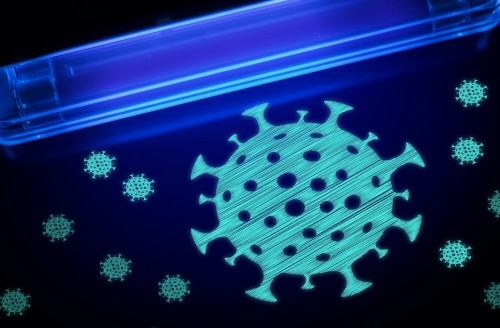Ultraviolet light of wavelengths between 200 and 280 nm is known as ultraviolet C light, of UVC. Using 222 nm UVC light is safe around humans, said the researchers from Hiroshima University, who have published their study in the American Journal of Infection Control.
As in vitro experiment by the researchers showed that 99.7 per cent of the SARS-CoV-2 viral culture was killed after a 30-second exposure to 222 nm UVC irradiation. Tests were conducted using a UVC lamp. A solution containing the virus was spread onto a plate. The researchers allowed it to dry before placing the UVC lamp 24 cm above the surface of the plates.
A wavelength of 222 nm UVC cannot penetrate the outer layer of the human eye and skin, so it won’t harm the cells beneath. But 254 nm UVC germicidal lamps harm exposed human tissues, and can only be used to sanitise empty rooms.
The researchers suggest further evaluation of the safety and effectiveness of 222 nm UVC irradiation in killing SARS-CoV-2 viruses in real-world surfaces.
UV light, or the ultraviolet part of the spectrum, is easily absorbed by certain nucleic acid bases in DNA and RNA, which can cause them to bond in ways that are hard to fix.
But not all UV light is the same. Longer UV waves, called UVA, don't have quite enough energy to cause problems. It's the mid-range UVB waves in sunlight that are primarily responsible for killing microbes and putting our own cells at risk of Sun damage.
Short-wave UVC radiation has been shown to be effective against viruses such as SARS-CoV-2, even while it's still safely enveloped in human fluids.
But this type of UV doesn't usually come into contact with Earth's surface, thanks to the ozone layer.
"UVC is great for hospitals," says Oregon State University toxicologist Julie McMurry. "But in other environments – for instance, kitchens or subways – UVC would interact with the particulates to produce harmful ozone."
In July 2020, an experimental study tested the effects of UV light on SARS-CoV-2 in simulated saliva. They recorded the virus was inactivated when exposed to simulated sunlight for between 10-20 minutes.
"Natural sunlight may be effective as a disinfectant for contaminated nonporous materials," Wood and colleagues concluded in the paper.
Luzzatto-Feigiz and team compared those results with a theory about how sunlight achieved this, which was published just a month later, and saw the math didn't add up.
This study found the SARS-CoV-2 virus was three times more sensitive to the UV in sunlight than influenza A, with 90 percent of the coronavirus's particles being inactivated after just half an hour of exposure to midday sunlight in summer.
By comparison, in winter light infectious particles could remain intact for days.
Environmental calculations made by a separate team of researchers concluded the virus's RNA molecules are being photochemically damaged directly by light rays.
This is more powerfully achieved by shorter wavelengths of light, like UVC and UVB. As UVC doesn't reach Earth's surface, they based their environmental light exposure calculations on the medium-wave UVB part of the UV spectrum.
"The experimentally observed inactivation in simulated saliva is over eight times faster than would have been expected from the theory," wrote Luzzatto-Feigiz and colleagues.
"So, scientists don't yet know what's going on," Luzzatto-Fegiz said.
The researchers suspect it's possible that instead of affecting the RNA directly, long-wave UVA may be interacting with molecules in the testing medium (simulated saliva) in a way that hastens the inactivation of the virus.
Something similar is seen in wastewater treatment – where UVA reacts with other substances to create molecules that damage viruses.
If UVA can be harnessed to combat SARS-CoV-2, cheap and energy-efficient wavelength-specific light sources might be useful in augmenting air filtration systems at relatively low risk for human health.
"Our analysis points to the need for additional experiments to separately test the effects of specific light wavelengths and medium composition," Luzzatto-Fegiz concludes.
With the ability of this virus to remain suspended in the air for extended periods of time, the safest means to avoid it in countries where it's running rampant is still social distancing and wearing masks where distancing isn't possible. But it's nice to know that sunlight may be helping us out during the warmer months.

A study has found that using ultraviolet C light with a wavelength of 222 nanometres (1 nanometre is a billionth part of 1 metre) effectively kills SARS-CoV-2, the virus that causes Covid-19.




